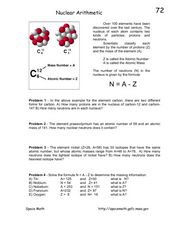Pearson
The Chemical Context of Life
An educational presentation includes atoms, molecules, the four major elements, as well as neutrons and protons. Additionally, slides focus on atomic number, mass number, atomic weight, polar and nonpolar covalent bonding, ionic bonds,...
Mr. Jones's Science Class
Parts of the Atom
Up and atom! After labeling the parts of an atom, young chemists answer 16 diagram-based questions that deal with protons, neutrons, electrons, and atomic number.
It's About Time
Are Atoms Invisible?
Wow, an experiment that allows the class to participate in a missile war! Pupils discuss Thomsons's theory of cathode rays and simulate Rutherford's historical experiment to learn about atomic structure. They conclude this fourth lesson...
Virginia Department of Education
The Modern Model of Atomic Structure
The difference between atomic mass and atomic number can be confusing for some young chemists. Help your class better understand the concepts by allowing them to sketch an atom on paper and then discuss their experience. Upon completion...
Shelby County Schools
Atomic Structure Worksheet
Teaching young scientists about atoms is no small task, but this series of worksheets will make it a little easier. From creating and labeling Bohr models, to identifying information provided in the periodic table of elements, this...
T. Trimpe
Atomic Basics
Get down to basics with these worksheets on the structure of atoms. Challenging young chemists to identify information from the periodic table and create Bohr diagrams and Lewis dot structures for different elements, this resource would...
Curated OER
The Number of Neutrons
Although the focus of this learning exercise is the neutron, you cannot talke about them without also dealing with protons and electrons! Chemistry kids fill in a table of 14 elements, identifying the mass, atomic number, isotopic...
Curated OER
The Atom Board - Making Atoms
In this atom activity, chemists learn how to determine the number of protons, neutrons and electrons in an atom using the atomic mass and atomic number. They complete a chart of the subatomic particles and use marbles to represent...
Curated OER
Nuclear Arithmetic
In "Nuclear Arthmetic," first-time physical scientists examine atomic structure and the periodic table of elements. The are given the formula, "N = A-Z," in which N is the number of neutrons, A is the atomic mass, and Z is the atomic...
Curated OER
All About Circuits ~ Atomic Structure
For this interactive Internet assignment, physical science investigators answer 11 questions about the atom, the subatomic particles, and atomic structure. They can click on "Reveal Answer" to discover if they are correct. They also...
Curated OER
Atomic Structure and Ionic Bonding (A Visual Approach)
Using toothpicks, marshmallows, and round colored sticky dots, physical science enthusiasts build models of an atomic nucleus. For this eighth grade chemistry lesson plan, they play an atom-naming game with the models that they have...
Curated OER
Atoms and Elements: An Introduction
Students are able to discuss the difference between a proton, a neutron and an electron. They also can explain the difference between an ionic and a covalent bond. Students know the main structure of atoms and molecules. Student are able...
Mr. E. Science
The Periodic Table
This science presentation focuses on the elements in the periodic table. It begins with the parts of an atom, explaining atomic mass and atomic number, valence electrons, and isotopes. Then it moves on to discuss various ways of...
Mr. E. Science
Magnetism and Electromagnetism
The biggest magnet in the world is at the Los Alamos National Laboratory in New Mexico and can reach 100 tesla. By comparison, magnets that lift cars are about two tesla. The 11th presentation in this series covers magnetism, focusing on...
Curated OER
Distinguishing Between Atoms
Every type of question is used to query young chemists about atomic structure. A vocabulary list tops the page before fill in the blanks, true/false, and matching questions are listed. This is a neatly formatted and pertinent worksheet...
Curated OER
Chemistry: Atomic Number and Mass Number
All you will find here is a simplistic chart of 17 elements (hydrogen is repeated) for chemistry beginners to fill in. They list atomic number, mass, and the numbers of protons and electrons. There are three critical thinking questions...
Curated OER
Protons, Neutrons and Electrons Homework
Perfect for reviewing atomic components, this worksheet simply consists of a large, easy-to-read chart of 11 elements. Chemistry learners fill in the missing element symbol, number of protons, neutrons, and electrons, the atomic mass and...
Curated OER
Protons, Neutrons, and Electrons
Using the periodic table of elements, young chemists fill in a chart of isotopes to show the atomic number, mass, charge, number of protons, number of neutrons, and number of electrons. The chart is followed by 11 questions that...
Curated OER
Countdown Challenge
In this countdown challenge worksheet, students find the 10 common elements from the human body, earth's crust, and ancient times and color code them. Students fill the atomic number of the elements in a given periodic table.
Curated OER
Chemistry Worksheet (Mole)
In this chemistry worksheet, students identify and name the number of neutrons, electrons, and protons for each. Then they illustrate how the electrons are arranged in a cloud. Students also find the relative number of atoms in the two...
Curated OER
What Do Atoms Look Like?
In this atomic structure worksheet, students answer eleven short answer questions about the structure of atoms including the number of protons, neutrons and electrons. Students indicate the differences in isotopes of atoms and what the...
Curated OER
The Elementary Particle Masses
In this elementary particle mass worksheet, students calculate the mass of elementary particles in kilograms and million electron Volts. Students solve 4 problems finding Top Quark mass, total quark mass of a proton and Strange Quark mass.
Curated OER
The Atoms Family Album
In the atom activity, students read a story about the "Atoms Family" and are given descriptions of the structures of atoms through the story. Students interpret the descriptions by drawing the described atom structure, they name of the...
Curated OER
The Atom
In this atom worksheet, students complete a graphic organizer for the structure of the atom. They include the definition of the mass number, the atomic mass, the atomic number, the protons, neutron and electrons.

























